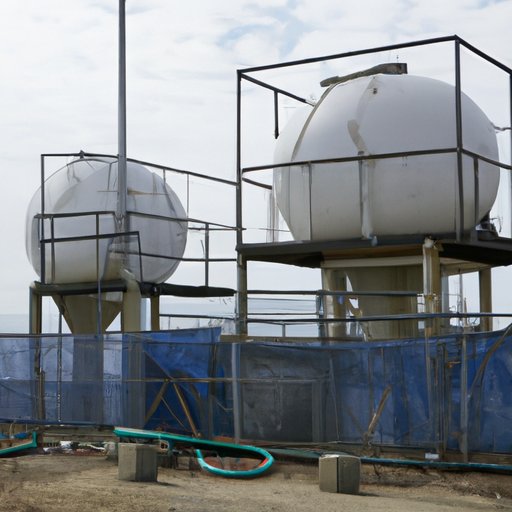I. Introduction
If you rely on a well for your water supply, a well pressure tank is an essential component of your system. However, these tanks don’t last forever, and it’s essential to understand how long they can be expected to operate. Examining the lifespan of a well pressure tank, its signs of wear, and maintenance tips can help you avoid significant repairs and replacement expenses.
II. The Lifespan of a Pressure Tank
On average, a well pressure tank can last between 8-12 years, although it’s possible to extend that lifespan through proper maintenance (more on that later). Factors such as the water quality, usage, system pressure, and the environment can all alter a pressure tank’s lifetime. Well-made tanks featuring high-quality materials and workmanship will generally last longer.
III. Signs that Indicate a Pressure Tank is Nearing the End of Its Life
Although pressure tanks will degrade over time, some signs indicate that it may be time to consider replacement.
- Reduced water pressure: If you notice water pressure dropping, it could indicate that the tank’s internal bladder might be ruptured or has worn out.
- Fluctuating pressure readings: If you experience fluctuating pressure readings in your well pump system’s pressure gauge, it could indicate that the pressure tank’s bladder is damaged or worn.
- Noisy operation: Unusual sounds like banging or gurgling can indicate high water flows that are damaging to the pressure tank.
IV. Tips for Extending the Lifespan of a Pressure Tank
Thankfully, there are steps homeowners can adopt to extend their pressure tank’s lifespan and avoid costly repairs or replacement.
- Regular inspections and cleaning: Inspecting the pressure tank every few months and cleaning it when necessary can remove harmful contaminants and debris that might damage the tank.
- Monitoring pressure levels: Regularly observing pressure levels and fixing any significant fluctuations could prevent the tank from overworking.
- Addressing issues promptly: When signs of wear are detected, the homeowner or a licensed professional can repair or replace the tank.
V. Risks Associated with a Failing Pressure Tank
Allowing the pressure tank to degrade without addressing the issue can result in damage to the well pump and plumbing system, making repairs more expensive and time-consuming. The most significant risk, however, is the potential for pollutants to enter the water supply. A damaged tank could allow rust, debris, and other harmful substances to flow into the water supply, harboring dangerous bacteria and impurities.
VI. Different Types of Pressure Tanks
There are three primary types of well pressure tanks available.
- Steel pressure tanks: These tanks’ average lifespan is between 5-10 years, depending on the water quality and level of maintenance. Steel pressure tanks are affordable and easy to find, but they’re also prone to rust and corrosion.
- Fiberglass pressure tanks: These tanks offer a longer lifespan, lasting between 10-15 years with proper care. Resistant to rust and corrosion, they are typically more expensive than steel pressure tanks.
- Bladder pressure tanks: These tanks are also known as diaphragm tanks and are widely regarded as the best choice for homeowners. With proper maintenance, bladder pressure tanks can last up to 20 years. These tanks utilize a flexible bladder to maintain the pressure level and eliminate some of the waterlogging issues that steel and fiberglass tanks can experience.
VII. Cost-Benefit Analysis of Replacing an Aging Pressure Tank
If your pressure tank starts to show signs of wear, you might wonder if it’s worth replacing. Well, a new pressure tank can cost between $400-$1000, depending on the type and size of the tank. Installation can also add a few hundred dollars to the expense. Although there is a significant upfront cost, replacing an aging pressure tank can prevent more extensive repairs or replacements down the line, potentially saving thousands of dollars.

VIII. Stories or Case Studies from Homeowners or Well Service Professionals
Many homeowners report that their pressure tanks can last longer than a decade with proper maintenance. Annual inspections and maintenance performed by well service professionals can identify problems early, saving homeowners both time and money. In contrast, neglecting their tank’s upkeep can result in expensive repairs, as well as health risks and supply disruption from polluted water.
IX. Conclusion
Although well pressure tanks aren’t typically the most exciting topic, understanding their lifespan and importance does not have to be difficult. Proper maintenance can ensure that your pressure tank lasts longer and avoids more extensive repairs or replacement expenses. Paying attention to warning signs, and promptly addressing any issues may help prevent supply disruptions and polluted water. By taking small measures to ensure the durability of your pressure tank, you can save yourself from significant costs and headaches in the future.
If you are unsure about the status of your well pressure tank, seeking guidance from professionals can provide peace of mind. Remember, preventative measures and proper care can protect your home’s water supply and promote the lifespan of your pressure tank.
(Note: Is this article not meeting your expectations? Do you have knowledge or insights to share? Unlock new opportunities and expand your reach by joining our authors team. Click Registration to join us and share your expertise with our readers.)
